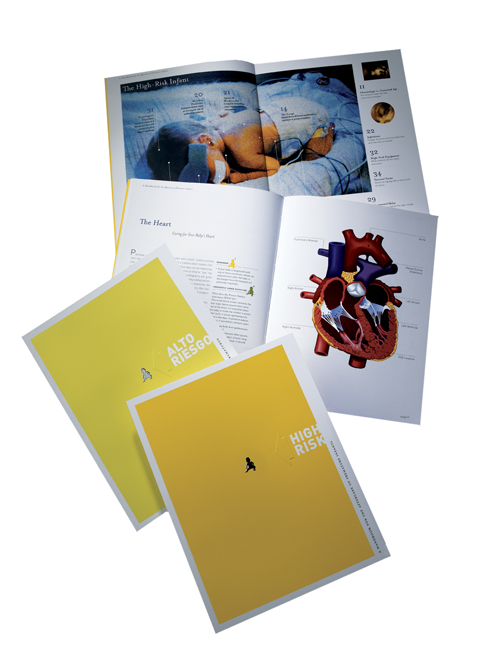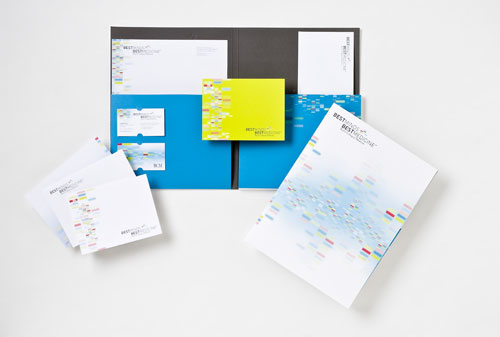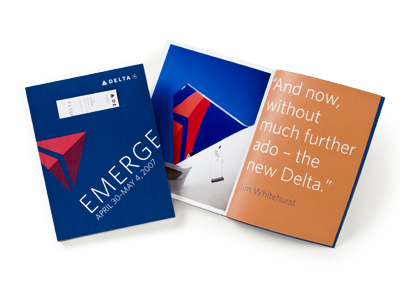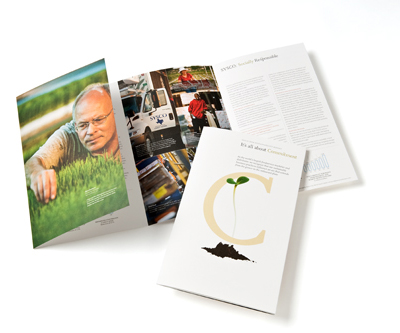
Savage specializes in results-driven corporate design and branding. For more than three decades, clients of all sizes and industries have brought their branding, marketing, and communications challenges to their doorstep – in every shape and form.
AIGA Houston’s John Luu was able to stop by Savage to speak with Paula Savage Hansen, CEO, Bethany Haley, President & Brand Strategist and Dahlia Salazar, Creative Director to learn more about Savage, their history and what Smart. Fresh. Human means.
John Luu / How did all of you guys first get into design?
Bethany Haley / I actually majored in graphic design thinking I would go into that field after college but after a couple of internships realized that it wasn’t my core strength, I was better on the idea-generation side of it and after more schooling and life outside of graphic design ended up going back and getting my MBA to learn about corporate strategy, entrepreneurship, marketing, and how to run businesses. My contribution to this company is to work with our clients on their core strategy and positioning.
Dahlia Salazar / I’ve always wanted a job in design since grade school. I was always interested in the arts and once I graduated from the Art Institute of Houston I was, for a year and a half, at an advertising agency, long enough to know I didn’t want to work at an advertising agency. So I came here to Savage and I’ve been here ever since.
Paula Savage Hansen / Well I guess mine was sort of by accident. My father always thought that I should be in what he called “Commercial Art” I think mainly because he always wanted to be in it and he figured that I could draw so maybe I could do that. But it wasn’t really what I was too interested in because he had me convinced that I had to be able to support myself once I graduated and I didn’t see any financial future in it. So I was going to be a math major but I didn’t do as well as I should have. My father talked me into trying art for one semester and if I didn’t like it he would never bother me about it again.
I loved it. I never went back and that’s all I’ve known, it’s been my passion since so… he was right. I think that we learn that sometimes our parents know us better than we think that they do. That’s how I got into it. If you want to know about my first job, I won’t go into all of that.
My second question—I didn’t realize you were going to be part of this discussion but… how did you come to join Savage?
PSH / I started it. (laughter) That’s mine, y’all can go ahead.
DS / Like I mentioned my first job was in an advertising agency and that was real good experience but I wanted to get into a studio environment and this was a really good studio even back then, Savage had a really good reputation. So I joined it and it was a much better environment for me in terms of creative freedom and creative development.
BH / Well some people may know this and some people don’t but Paula Savage is my mother so I literally grew up in this business. From the beginning of my time I’ve been exposed to this great business and after going to college and sowing my oats in other places and after business school came on to work for Savage so it was just a natural transition for me to come into the family business.
If you had 3 words to describe Savage what would they be?
BH / I think we’re all going to have the same answer, which is; Smart Fresh and Human. It’s on everything. And we spent a very long time…
DS / …Deducing it down.
BH / …clarifying what those words are and we’ve come to live and breathe them so I hope that everyone in this organization would come up with those same three words. Because they’re very meaningful, not just to us, but to the value we provide our clients and the work that we do.
According to your fact sheet; Savage has six partners,, all of which have a background in Graphic Design. How has that shaped the vision of the studio?
PSH / That’s an easy and a hard question because we all come from… even though we’re all in graphic design, we all have different disciplines. Part of being a partner though goes more to the business side of it. I’ve tried over the years—it’s very typical in this business for designers to not necessarily have a great career path at a firm. After a certain period of time they tend to move somewhere else in order to move up rather than stay with the same firm. We had such great people here that we didn’t want to lose them for that reason because I felt that they contributed a lot of time and effort to the company and they should have an opportunity to be an owner in the company. I’ve made that offer over the years to several people and currently we have six partners, including me. And we have different retreats to help plan and define “what’s ahead for our firm and the profession and where do we fit into all of that”
We basically plan, at least once a year and also meet twice a month on a very regular basis to talk about where we are going with the firm and what’s happening with our clients. What is happening internally and externally and so on. I think that goes a long way in shaping what it is that we do, I would say that the company has always had a very entrepreneurial spirit about it and we like to stay that way.
Also it helps us to distribute the management across different people so we have a four person sort-of day-to-day management group and that consists of three of the partners and our controller and that’s more on the management side. Part of their time is taken up with the management of the company. Two of the partners prefer to be almost solely in design, doing design and doing the work, and they still participate in carrying the design banner, taking that one step further in terms of keeping us on track as far as some of our core competencies. Even though those have extended beyond just the pure design aspect of it. It’s design that has a strategy behind it. Strategic Design is what we do. The thinking is just as important as the aesthetic of what we are doing.
I think that having the responsibilities distributed over a group of people rather than just having one person responsible also helps the employees here, they know they can go to more than just one person in order to get an answer to something or get something done. In a lot of cases it also has meaning to our clients because it allows them to know that they are working with the principal at all times. I think that’s pretty important to our clients. They know that there’s somebody really caring about their account and whether we’re doing a good job or not.
BH / I think what’s interesting too is that, as the company has transformed into more brand development strategy, we can continually execute on that strategy. You hear a lot of grief being given to consultants in general because they come in and they tell you what to do and then they leave and they leave you to execute. Because we are grounded in graphic design and we understand the value and the power of design as a differentiator for companies, when we come in and go through the strategic process then we can deliver the solution and execute a plan and walk away having the client comfortable with the fact that they have deliverables that they can use and measure against. That’s the other reason that I think that everyone’s past or experience in graphic design is pretty critical.
Savage is one of the oldest and most respected design firms in Houston. What do you think is the key to Savage’s longevity and continued relevance as a studio?
PSH / I think one of the reasons that we stayed around is that we made a lot of good business decisions and a lot of that goes back to the entrepreneurial spirit that we have here. We’ve been on —you know they talk about the leading edge, the bleeding edge —we’ve always been on the bleeding edge. We have taken it as part of our responsibility to understand where the technology is going and how it can help our clients.
I think it’s really focusing on our clients and bringing new ideas and keeping client-centric. So it’s planning and staying ahead of the game and really being a partner with your clients so that you are not losing your clients. And understanding how to market; doing what you say and practice what you preach.
BH / We also have a lot of financial discipline as well. There’s investment in innovation and staying on the edge and investing in your company and yourself. We’re business people too, that’s based on 36 years of Paula doing this, we’ve got a couple of MBA’s, we have very senior level treasurer and controller and so we have financial discipline, we have processes and procedures in place and part of our culture is to have processes and procedures so that we’re smart.
PSH / That’s true. I’ve even had people over the years say “Oh my gosh, I’ve never worked at a place that was so well organized as you are here but… I like it” You don’t necessarily think of creative people as liking that kind of thing but I think that even if you are a designer and you look at a blank sheet of paper. Well that sheet of paper still has four edges to it, I mean there has to be some sort of a foundation in place for you then to be able to think freely and be creative. That’s just part of my philosophy.
Recently Savage has branched out into adjacent forms of communications, PR and Social Media. Do you have any insights into how visual designers can adapt to these new integrated tools and approaches?
DS / It kind of goes back to what Paula said earlier. We’ve made the time to learn about those new technologies because whether people are utilizing them right now or not, we owe it to our clients who’ve always evolved based on their needs and so learning about technology and social media and optimization, all of those things. We make the effort to invest the time to learn it so we can then go and accurately apply it to what our client’s needs are so that fuels the partnership that Paula was talking about earlier and because of that we maintain a lot of long term relationships with our clients. We’re going to them a lot of times and they might not be interested in it initially but we will get the call back; “Remember the meetings?” or “Remember that call?”, historically it always happens.
BH / Also, internally, we challenge our designers to know that stuff. It becomes a requirement; this is the technology that’s here, this is the form of communication that we have to provide to our clients, and whether somebody is fresh out of school or has been working with Savage for twenty-something years, we put them on projects and client teams that are going to push their comfort level a little bit to learn that. And also we have the expertise in house to provide some mentorship and guidance but we really want everyone to participate in learning and growing with new technology. What’s also interesting in what you mentioned; social media and investor relations, and there is a split in where it used to be the innovation was in technology, like using the web and now it’s all about social media tools and where we’ve seen innovation in recently is how you effectively communicate with a variety of different audiences. Thinking about the internal employee audiences and thinking about the customer, thinking about supplier communications and finding the right tools to maximize the reach and impact you have upon those clients so part of us branching out into adjacent areas is only about finding and being able to provide the best means of communications for that audience. That’s been part of our path, trying to access these skills we know are important for those communications plans.
PSH / Another side of that is we do a lot of branding and that’s just part of that. Once you develop the brand you need stuff to communicate it so there is a PR component to that we do like to provide. We don’t do a lot of advertising either, we don’t do a lot of ads but we do image ads so the part that relates to the project, we want to provide to the client.
How long have you been members of AIGA?
BH / Paula is the longest standing member of AIGA in Houston! And three of our six partners are in the top ten longest standing and Paula is the longest standing member. Which is really fascinating because it shows how much support she’s given.
PSH / I think what it shows is how important it is, even when times are bad, to maintain some sort of a national professional affiliation so that you have people on a national level you can bounce ideas off of, that you can talk to and you can find out what’s going on. You can participate in your profession because it’s not just about being with your clients all the time, you have to participate in our profession also. It’s like lawyers and doctors practice law and practice medicine. You have to practice design communications and that’s just part of it. It’s important.
What do you get most out of AIGA?
BH / What we talked about as a firm, we really want all of our designers—actually we want everybody at Savage to participate in some sort of professional development and for designers the number one is AIGA and so they benefit, they learn more and they network they create these relationships and share knowledge that not just benefits them professionally but benefits our firm professionally.
It’s also a good virtuous cycle. We get new designers, the designers learn more, they help us help our clients better, and honestly you can’t do that just within the walls of the firm, you have to look outside to the community as well. So we’ve gotten a lot from AIGA and from other organizations just through those means and also it’s been a recruiting tool.
DS / The standards and policies that AIGA has developed that are now industry standards those are all very helpful in terms of being accepted and communicating those standards back to our clients so that they are aware that there are some standard practices and procedures within this profession.
PSH / We’re not, we don’t have AIA and those kinds of things following us but AIGA has provided a lot of legitimacy to our profession.
What do you look for when looking at design portfolios?
DS / I look for, obviously the thinking, and the thought process behind any type of design solution. I look at someone’s communication skills, how they present themselves. Are they able to articulate effectively what the challenge was and how they arrived at their solution. Just the craft of the portfolio itself. Is it polished? Is it well presented or is it falling apart at the seams? That gives you a lot of insight into a person in terms of the amount of detail and what they put into their work. I mean am I going to be able to put this person in front of a client? Also whether they’ve done any kind of research on us. It’s always good to have someone that’s actually studied our background and has some questions and comes prepared and is interested in not only presenting themselves but in asking questions about the studio, that tells me they’ve done their homework. Do you guys have anything else you might want to add?
BH / No that’s really dead on.
PSH / Besides having really really great design. (laughter)
DS / That’s a given.
Do you have any advice for designers still in school?
BH / Our biggest consensus on advice for designers still in school is to take some courses outside of graphic design. Consider a class in business writing or a class in general communication, how to present in presentations or public speaking. A lot of those courses are offered in these schools and students just get into these little pigeonholed world of graphic design and forget when they come out that their clients are in the real business world and understanding where they are coming from and how to speak their language and how to present to them professionally, how to stand in front of a board even, is really going to be an extremely important skill and a differentiator for a student coming out of school and when they’re interviewing will definitely set them apart.
DS / And start to think about that before their senior year. They can call and hopefully get face time with some folks around town. Typically you see people at the portfolio review and it’s their senior year and they’re about to head out into the market but it would be helpful if they did that in their junior year or earlier start researching and trying to get a lay of the land in terms of what is available to them
BH / And most design firms in Houston, this is an assumption, but it is our personality; everyone is open to informational interviews. Don’t wait until you need a job, start using some networks and start talking to people. I mean we’ll spend twenty minutes or thirty minutes talking to somebody, just talking about their portfolio or talking about what opportunities we see out there for them. I don’t think people are really taking advantage unless they’re really looking for an internship or looking for a job.

Sappi Paper: Ideas that Matter

Baylor College of Medicine "Best Minds. Best Medicine." Identity Campaign

Dell, Inc.: Worldwide Employee Communications Campaign

Delta Air Lines: Emerge Book

Sysco Corporation 2008 Sustainability Report
To learn more about Savage please visit their website at www.savagebrands.com.
If you would like your studio featured on AIGA Houston please contact John Luu, info@houston.aiga.org for more information.